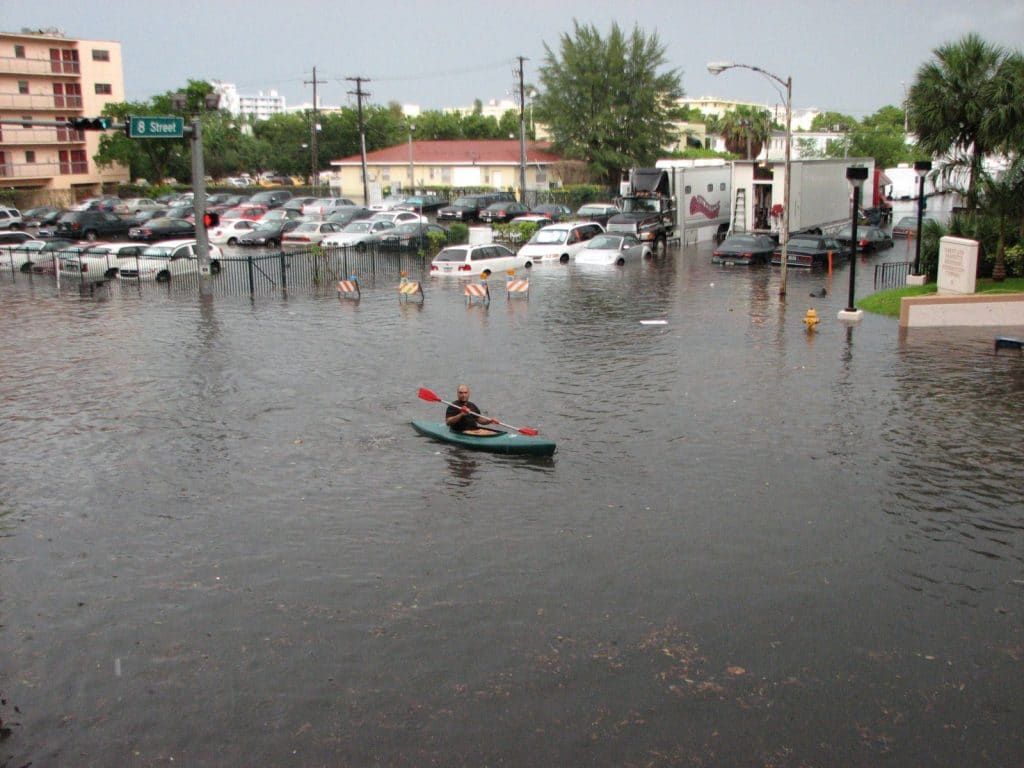Make 2022 the year you become a climate influencer
By John Morales | January 4, 2022
 Flooded streets in Miami Beach (Photo by maxstrz / Flickr)
Flooded streets in Miami Beach (Photo by maxstrz / Flickr)
In 2009, prior to taking office for his first term, the City of Miami’s mayor-elect held a news conference. When asked about the threat climate change posed to the city and how his administration might tackle the issue, Tomás Regalado said his understanding of the climate issue was that it was still “being debated by scientists.”
At the time, the accelerated planetary warming caused by the enhanced greenhouse effect was well understood, and the Magic City had billions of dollars of ocean-exposed infrastructure along its 10-mile-long coastline. On air, I reported the soon-to-be mayor’s view and contrasted it with the mounting evidence that global warming was indeed a threat to the city. By 2020, Miami had been singled out as the most vulnerable coastal city in the world, with more assets threatened by surging seas than any other.
During the mayor’s first term, Regalado focused on an austerity plan to restore the city’s finances. Nothing was said publicly about the risk of a climate crisis. Behind the scenes, José Regalado, one of the mayor’s sons who was then in his 20s, had moved in with his recently widowed father. José was pursuing an underwater photography career and had traveled to some of the most iconic coral reefs in the world, including the Palau and Vanuatu archipelagos in the tropical western Pacific. He was keenly aware of the effects of climate change on the reefs. And he wanted his dad the mayor to learn about global warming.
José would get up before dawn to join his father in their morning ritual of news and Cuban coffee. He broached the subject of climate, and his dad appeared receptive. “I would bring out a white board, and we started from square one,” said José Regalado. With basic science facts taken from sources ranging from NOAA to YouTube, the son eventually got his father to understand what the City of Miami was facing. To overcome the mental barrier that temporal distance presented—or the perception that sea level rise is something for others in the future to worry about—José took his dad Tomás to pricey high-end condominiums where some days the tide was already flooding the lower facilities. At the time, according to a University of Miami study, Miami was in the midst of an alarming 400 percent increase in tidal flooding events over a 10-year period.
“My son educated me on climate change and sea level rise,” Regalado declared during his second term, a stunning reversal from his earlier position. By 2016, the mayor had introduced a proposed bond issue to borrow money for improvements that would mitigate flooding. While the idea initially failed to be approved in the City Commission, it was later expanded and reintroduced in 2017 to include climate resiliency more broadly, adaptation, and affordable housing, among other issues. With a possible assist from powerful Hurricane Irma, which in September of that year brought a deep and damaging storm surge to Miami, voters approved a $400 million bond in the November 2017 election. Nothing motivates people to vote for flood improvements like seeing five feet of seawater running like a raging river down city streets.
Amazingly, a former climate skeptic came to understand that climate change was already impacting his constituents and would do so more severely in the future. While it was Regalado’s predecessor, Manny Díaz, who planted the seeds for climate action by shepherding a full sustainability-focused revamp of Miami’s zoning rules, I think historians may look at Regalado as the one who first bankrolled sea-rise flooding mitigation and climate adaptation in the Magic City. A scientist didn’t get the mayor to do that. Regalado trusted his son, and José delivered the message.
Your turn to help someone better understand the global climate crisis as a locally and personally relevant problem could come up anytime. Maybe it already has. This year, get better at it! You don’t need a whiteboard. You just need to be relatable.
Know thy audience, know thyself, know thy stuff. These three commandments of communication were set forth by the late Stephen H. Schneider, a Stanford University professor of environmental biology and global change as well as a member of the United Nations Intergovernmental Panel on Climate Change. His intent was to provide guiding principles for scientists preparing to share their work. But I say these principles apply to everyone.
You probably already know your stuff. You are climate literate if you understand the basic workings of the earth’s climate system, know how to distinguish between credible and non-credible scientific information, and can communicate about climate change in a meaningful way.
It’s very important to know your audience, too. You wouldn’t approach a climate conversation with a nine-year-old the same way as you would with an adult. And each adult is different. Someone’s sense of community belonging, and their personal worldviews, are strongly influencing whether they’ll even listen to you in the first place.
As a television meteorologist I might be a relatable and well-known scientist. But I am not the mosttrusted conduit for science information. That distinction is yours! That’s why it’s crucial that you know thyself. You already have a powerful voice in science communications. Human nature already makes you a natural influencer.
For example: Social scientists have found most people don’t take immediate action to save life and property when faced with severe weather. Only 10 percent take shelter at the first sign of danger. Instead, many of us may want to look out the window (bad idea) to see whether there’s a menacing sky or turn on the television to hear what a local meteorologist like me is saying. Others open a weather app to test-drive their radar-interpretation skills. People seek to confirm the threat. But even this is sometimes insufficient to get people to take actions to safeguard themselves and their family.
Tornado sirens could go off. You may have one of those special NOAA Weather Radios that sound an alarm when your part of the county is inside the tornado-warned area. Your cellphone may show an alert on the screen or sound an alarm. But all those horns and beeps become white noise until you hear from someone! That someone is probably not an expert in tornadoes, but that doesn’t matter. The messenger is more important than the message. Even after receiving the official alert from an authoritative government agency and later confirming that the threat is real (say, through a television weatherman), we don’t internalize or personalize the menace until we’ve talked about it with someone. Whether it’s through a call, text, or other instant-messaging means, people want to talk to family (kin are often the most trusted messengers in the room), friends, or neighbors.
Your kinship—blood relation or otherwise—makes you the most trusted messenger. A bond exists because you share a common background, neighborhood, friend, possibly common values, and are (mostly) viewed positively by your friend or acquaintance. You stand the best chance to break through the psychological barriers that can block a person’s acceptance of the facts and ability to act upon them, which in the case of an impending tornado or the rapidly changing climate might save a life.
That’s why for 2022 you should resolve to talk more about the changing climate. Find ways to relate and break the ice. “Gosh, this wildfire smoke is terrible!” or “It’s been so hot lately that I’m struggling to finish my jogging route,” are just two examples of ways in which you could introduce the subject matter into a conversation. If you suspect that the person you’re talking with has opposing views but shares a favorite hobby or activity with you, then start by talking about that shared passion. Later, you can tactfully interject about how it is being affected by global warming.
We need to defuse talking about climate change. The more we do, the more we will see others personalize and internalize the threat. Normalizing climate conversations can lead to more people calling for climate action, mitigation, and adaptation, as José and Tomás Regalado proved. And action on climate we need. Desperately.
Together, we make the world safer.
The Bulletin elevates expert voices above the noise. But as an independent nonprofit organization, our operations depend on the support of readers like you. Help us continue to deliver quality journalism that holds leaders accountable. Your support of our work at any level is important. In return, we promise our coverage will be understandable, influential, vigilant, solution-oriented, and fair-minded. Together we can make a difference.














